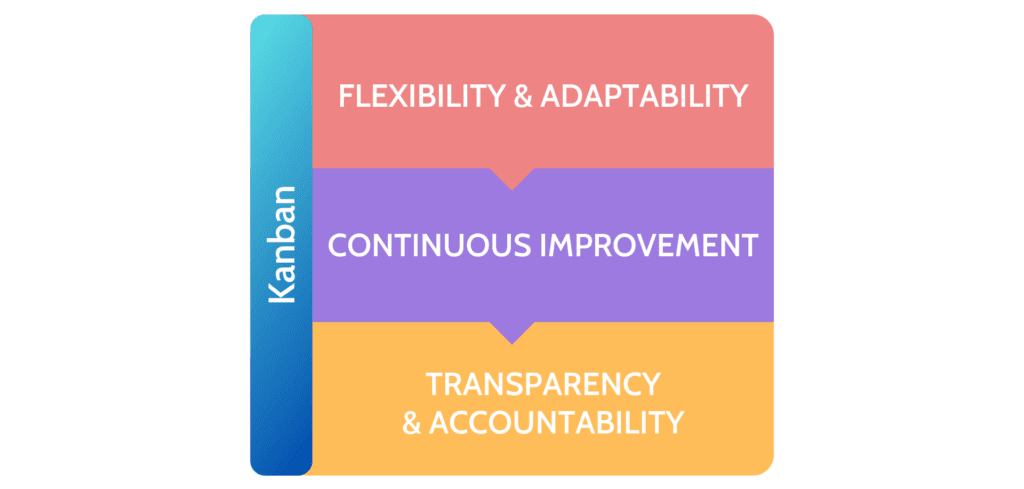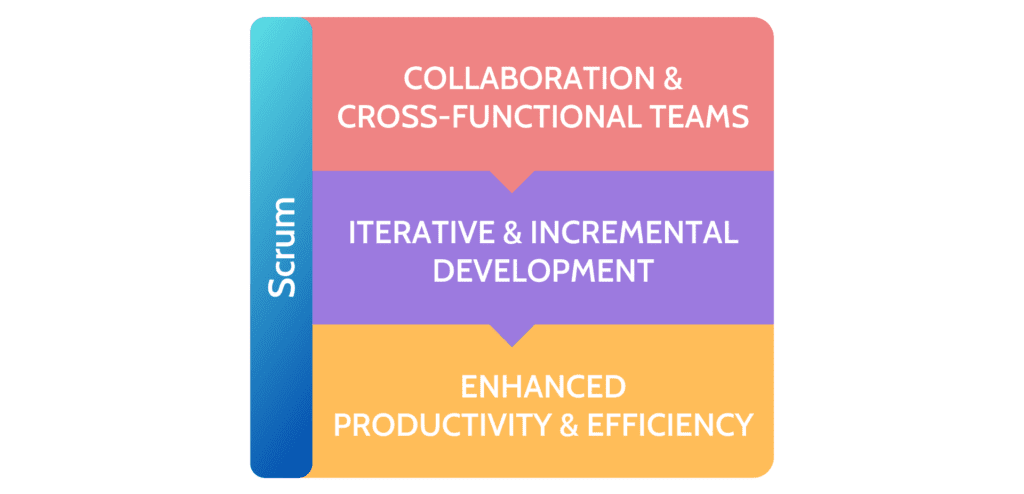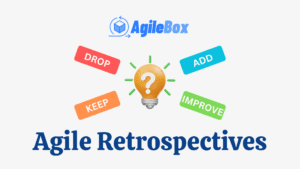Contents
I. Introduction
Agile methodology is a project management approach that breaks projects into phases and emphasizes continuous collaboration and improvement. Teams follow a cycle of planning, executing, and evaluating. The agile methodology consists of various frameworks, such as Scrum and Kanban, that provide guidelines and best practices for delivering software products.
Choosing the proper project management framework is crucial for the success of any project. It helps to align the project goals, scope, budget, and timeline with the expectations of the stakeholders and the team. Project managers can avoid common pitfalls and challenges by selecting a suitable framework, such as scope creep, poor communication, missed deadlines, and low-quality deliverables.
Kanban and Scrum are agile frameworks that help teams deliver customer value faster and more efficiently. Kanban focuses on visualizing the workflow, limiting the work in progress, and optimizing the flow of tasks. Scrum divides the work into fixed-length iterations called sprints, where the team plans, executes, reviews, and adapts the product. Both frameworks aim to improve collaboration, transparency, and feedback among the team members and stakeholders.
II. Understanding Kanban
A. Definition and origin of Kanban
Kanban is a popular agile methodology that helps teams deliver customer value faster and more efficiently. Kanban means “signboard” or “billboard” in Japanese, and it originated from the Toyota Production System (TPS) in the 1940s. TPS was a lean manufacturing system that aimed to minimize waste and optimize flow by using visual signals to indicate the status of work items.
Kanban in agile is based on the same principles of visualizing work, limiting work in progress (WIP), and optimizing flow. Kanban teams use a Kanban board to display their work items as cards on different columns representing different workflow stages. The team agrees on a maximum number of cards in each column at any given time, called the WIP limit. The team also monitors the flow of work items across the board and identifies any bottlenecks or inefficiencies that must be resolved.
B. Benefits of using Kanban

Flexibility and adaptability:
Kanban provides a flexible framework that allows teams to respond quickly to changes. As work items are visualized and WIP is limited, teams can easily adjust their priorities and make necessary adaptations based on evolving requirements or shifting customer needs.
Continuous improvement:
Kanban fosters a culture of continuous improvement within teams. By visualizing the workflow and regularly reviewing the Kanban board, teams can identify bottlenecks, inefficiencies, and areas for improvement. Through retrospective meetings, teams reflect on their processes, experiment with changes, and implement adjustments to enhance productivity and efficiency over time.
Transparency and accountability:
Kanban promotes transparency and accountability within teams. By visualizing the workflow and making it accessible to all team members, everyone can see the status and progress of work items. This transparency enhances collaboration, as team members can easily see who is responsible for specific tasks and where the team’s efforts are focused.
III. Exploring Scrum
A. Definition and origin of Scrum
Scrum is a popular agile framework that helps teams manage complex projects and deliver customer value. This framework is based on empirical process control, which means that teams use observation and experimentation to adapt to changing requirements and situations.
Scrum originated in the software industry, but it can be applied to any project involving uncertainty and creativity. It was first introduced by Jeff Sutherland and Ken Schwaber in 1995, based on their experience with software development projects and influenced by the work of Hirotaka Takeuchi and Ikujiro Nonaka on new product development.
B. Benefits of using Scrum

Collaboration and cross-functional teams:
Scrum encourages collaboration among team members who have different skills and perspectives. This fosters creativity, innovation and problem-solving. Scrum also promotes cross-functional teams that can handle all aspects of the project, from design to testing to deployment. This reduces dependencies, hand-offs and delays.
Iterative and incremental development:
Scrum divides the project into short cycles called sprints, usually lasting two to four weeks. Each sprint delivers a potentially shippable product increment that meets the customer’s needs and expectations. This allows the team to get frequent feedback, validate assumptions, and adjust as needed. Scrum also enables the team to prioritize and deliver the most valuable features early.
Enhanced productivity and efficiency:
Scrum helps the team to focus on the most important tasks and eliminate waste. It also empowers the team to self-organize, make decisions and take ownership of their work. Scrum provides transparency and visibility into the project’s progress, risks and issues. This helps the team to communicate better, collaborate more and improve continuously.
IV. Key Differences between Kanban and Scrum
Understanding the key differences between Kanban and Scrum is crucial in choosing the most suitable framework for a project or team.

A. Workflow management
1. Kanban: Visualizing flow and managing WIP
Using a continuous flow approach, Kanban focuses on visualizing flow and managing work in progress (WIP). Work items are represented as cards or sticky notes on a Kanban board, moving through different workflow stages. There are no set time frames, and tasks can be pulled into the system as capacity allows. The emphasis is on optimizing flow and maintaining a smooth, steady pace of work.
2. Scrum: Sprint-based development and time-boxing
On the other hand, Scrum adopts a sprint-based development approach with time-boxing. Work is organized into fixed-length iterations called sprints, typically ranging from one to four weeks. The team commits to delivering prioritized user stories or features during each sprint. The work is then completed within the sprint timeframe, providing a potentially shippable product increment at the end of each iteration.
Kanban’s continuous flow approach allows for greater flexibility and adaptability, as work items can be added or removed from the board as needed. It suits projects where requirements change frequently or teams require more agility to respond to customer needs. Scrum’s sprint-based approach provides a structured framework with defined time boundaries, allowing teams to focus on specific deliverables within each iteration. It is suitable for projects with well-defined requirements and where predictability and fixed timeframes are important.
B. Team structure and roles
1. Kanban: No prescribed roles, promotes self-organization
Kanban does not prescribe specific roles within the framework. It promotes self-organization, allowing team members to collaborate and determine their responsibilities based on their skills and expertise. The emphasis is on creating a flexible and adaptable team structure that can respond effectively to the work. Kanban fosters a sense of collective ownership and encourages individuals to take the initiative and contribute in areas where they can add the most value.
2. Scrum: Clear roles and responsibilities
Scrum, in contrast, defines clear roles and responsibilities for team members. These roles include the Product Owner, Scrum Master, and Development Team. The Product Owner is responsible for prioritizing the product backlog and ensuring the team delivers value to the customer. The Scrum Master is a facilitator, removing impediments and enabling the team to work efficiently. The Development Team consists of cross-functional members responsible for delivering the product increment.
Scrum’s defined roles provide clarity and accountability, ensuring that the respective roles cover each aspect of the project. The Product Owner, Scrum Master, and Development Team work together in a structured manner to achieve the project’s goals. On the other hand, Kanban offers more flexibility in team structure, allowing teams to adapt their roles and responsibilities based on the project’s needs and the skills available within the team.
C. Planning and prioritization
1. Kanban: Continuous flow, dynamic prioritization
Kanban follows a continuous flow approach without specific planning events. Work items are pulled into the workflow based on available capacity and team expertise. Prioritization is dynamic, allowing flexibility to reprioritize tasks based on changing needs. As new tasks are introduced or requirements shift, the team can adjust the order of work items to ensure optimal flow and timely delivery. Kanban focuses on managing flow and optimizing the efficiency of each work item as it progresses through the system.
2. Scrum: Sprint planning and backlog grooming
Scrum incorporates sprint planning and backlog grooming as critical planning and prioritization activities. Sprint planning occurs at the beginning of each sprint, where the Scrum Team collaboratively decides on the set of user stories or backlog items to be included in the upcoming sprint. The team estimates the effort required and defines a sprint goal. Backlog grooming involves refining and prioritizing the product backlog to ensure it is ready for the upcoming sprints. This includes breaking down user stories, estimating, and ordering them based on value and priority.
Kanban’s continuous flow and dynamic prioritization offer flexibility and adaptability to handle changing requirements effectively. It allows teams to respond quickly to new priorities and optimize the order of tasks based on immediate needs. With its sprint planning and backlog grooming, Scrum provides a more structured approach to planning, enabling the team to work in fixed timeboxes with a clear set of objectives for each sprint.
D. Change management and adaptability
1. Kanban: Embraces change, flexible to adjust
Kanban embraces change and provides a highly adaptable framework. It allows for flexibility in responding to evolving requirements or unexpected changes in priority. Kanban teams can easily accommodate new work items or reprioritize existing ones as needed without disrupting the overall workflow. The focus is on maintaining a continuous flow and optimizing the efficiency of work items. Kanban encourages a culture of adaptability, allowing teams to respond swiftly to customer feedback, market shifts, or emerging opportunities.
2. Scrum: Change within sprints is discouraged
Scrum follows a more structured approach to change management. Once a sprint has started, changes to the sprint goal or work items within the sprint are discouraged. This is to maintain stability and focus on the committed scope for the duration of the sprint. Changes are typically evaluated and incorporated in subsequent sprints during the sprint planning process. Scrum provides predictability and allows the team to deliver on its sprint commitments without interruptions.
Kanban’s flexibility and adaptability make it suitable for projects where requirements are likely to change frequently or teams must respond quickly to customer needs. It enables teams to seamlessly incorporate new work items or adjust priorities within the continuous workflow. With its emphasis on sprint commitments and stability, Scrum is better suited for projects where a higher level of predictability and consistency is desired.
V. Factors to Consider When Choosing

A. Project requirements and characteristics
Consider the specific requirements and nature of the project. Does it involve frequent changes, evolving priorities, or uncertain scope? Kanban’s adaptability makes it suitable for such scenarios. If the project has a well-defined scope and benefits from fixed-length iterations, Scrum might be a better fit.
B. Team dynamics and size
Assess the team’s dynamics, skills, and experience. Kanban allows teams to self-organize and adapt based on their strengths and expertise. With its defined roles and ceremonies, Scrum may be more suitable for teams that benefit from a structured framework and clear responsibilities.
C. Level of predictability and adaptability needed
Consider the desired balance between predictability and adaptability. Kanban provides greater flexibility and the ability to respond quickly to change. With its fixed-length sprints, Scrum offers more predictability and stability within the defined sprint scope.
D. Stakeholder involvement and collaboration
Evaluate the level of stakeholder involvement and collaboration required. Kanban promotes continuous collaboration and transparency, giving stakeholders a clear view of the work in progress. Scrum ceremonies like sprint reviews and daily stand-ups allow stakeholders to engage and provide feedback.
E. Existing organizational culture and processes
Consider the organization’s culture and existing processes. Kanban can be easily integrated into existing workflows and cultures as it focuses on incremental improvements. With its defined roles and ceremonies, Scrum may require more significant changes and cultural alignment.
By considering these factors, teams can make an informed decision when choosing between Kanban and Scrum. Each factor contributes to the overall suitability and compatibility of the selected framework with the project’s needs, team dynamics, stakeholder involvement, and organizational context.
VI. Conclusion
Kanban and Scrum offer distinct approaches to project management and workflow optimization. Kanban focuses on continuous flow, adaptability, and visualizing work processes, while Scrum employs time-boxed sprints, defined roles, and structured planning. When choosing between the two, evaluating project requirements, team dynamics, the desired level of predictability, stakeholder involvement, and existing organizational culture is crucial.
In conclusion, the proper framework for success lies in considering the specific project context, understanding the differences between Kanban and Scrum, and embracing a continuous improvement mindset. By selecting the most appropriate framework and fostering a culture of experimentation and adaptation, teams can optimize their workflows, improve collaboration, and deliver value effectively to meet customer needs.
AgileBox provides necessary functionalities throughout the Sprint process, enabling teams to streamline workflow, enhance communication, and improve collaboration. By leveraging these features, Agile teams can optimize their Sprint process and achieve their sprint goals more effectively.
Try out our app now: Agile Planning Poker, Retrospectives, Daily Standup for Jira













